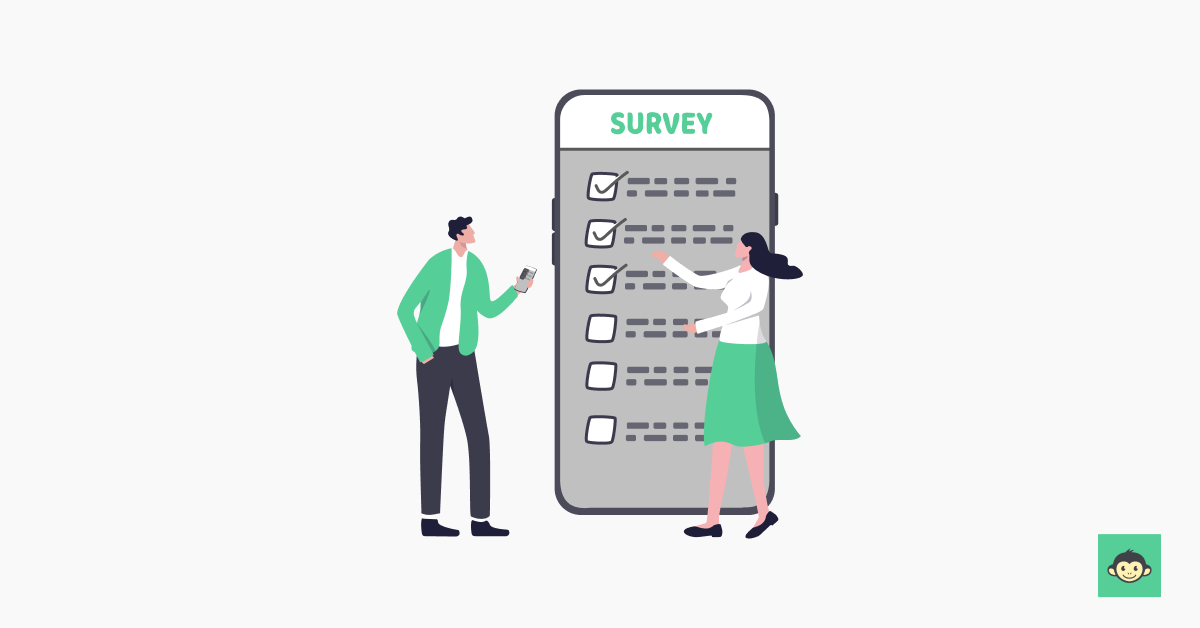What is survey fatigue: 10 Tips to avoid it and increase participation rates in the workplace

In the fast-paced realm of contemporary business, where innovation and adaptability reign supreme, one asset emerges as the linchpin of organizational success: the workforce.
These dedicated individuals serve as the bedrock of thriving companies, underscoring the importance of their engagement and satisfaction for sustained prosperity.
For leaders and HR professionals, recognizing the significance of cultivating a motivated and dedicated workforce is paramount.
Yet, harnessing the full potential of employees requires more than mere intuition or guesswork. Enter employee surveys – a vital tool that unveils the pulse of your organization, offering unparalleled insights into the thoughts and feelings of your team members.
As Winston Churchill once remarked, "To improve is to change, so to be perfect is to have changed often."
This axiom holds true when it comes to crafting effective employee surveys. Understanding their needs, challenges, and aspirations lays the groundwork for developing strategies that genuinely resonate with and empower your workforce.
What is survey fatigue?
Survey-taking fatigue occurs when individuals feel overwhelmed by the number, frequency, or length of surveys they are asked to complete. This can lead to decreased participation, rushed or incomplete responses, and overall disengagement from the survey process.
Factors contributing to this fatigue include survey frequency, length, question relevance, lack of action on input, and monotonous survey design.
This fatigue can negatively impact both employees and organizations, resulting in decreased participation rates, poor response quality, reduced engagement, and skewed data. Recognizing various survey fatigue types like response fatigue, survey format fatigue, feedback fatigue, and length of survey fatigue helps address specific disengagement issues.
Mitigating survey-taking fatigue is crucial for maintaining the value of surveys in gathering insights and driving change. By implementing strategies to address root causes and balancing response collection with respecting participants' time and energy, organizations can promote active participation and continuous improvement.
Incorporating customer feedback practices can also enhance the relevance and effectiveness of surveys, ensuring they remain valuable tools for both employee and organizational growth.
Reasons behind survey fatigue

Survey fatigue can be attributed to several factors that diminish employees' willingness to participate. By addressing issues related to frequency, length, relevance, and redundancy, organizations can create more effective surveys. This approach helps maintain high participation rates and ensures the collection of quality information.
Frequency:
Excessive survey requests can inundate employees, leading to feelings of overwhelm and annoyance. When employees are constantly asked to complete surveys, they may start to see these requests as interruptions rather than opportunities to provide meaningful input.
Length:
Lengthy surveys require a significant time commitment, which can be daunting for employees with busy schedules. Long surveys can lead to rushed or incomplete replies, diminishing the quality of the input collected. Employees may also experience fatigue midway through a lengthy survey, resulting in less thoughtful responses.
Relevance:
When survey questions feel disconnected from employees’ roles or experiences, they may question the purpose of providing information. Irrelevant questions can make the survey seem like a box-ticking exercise rather than a genuine attempt to understand and improve employee experiences.
Redundancy:
Repetitive questioning can frustrate employees, making them less inclined to participate. When employees encounter the same questions across multiple surveys, they may feel their previous responses were ignored, leading to disengagement.
Implementing shorter, more focused surveys, like pulse surveys, can alleviate the burden on employees. These surveys are designed to be quick and relevant, reducing fatigue while still gathering valuable insights.
Understanding and mitigating this fatigue can lead to more productive and satisfied employees, as well as actionable responses that drive organizational improvements. By considering these aspects, organizations can enhance their survey strategies, fostering better workplace engagement and overall employee satisfaction.
How survey fatigue can negatively affect workplace engagement?

Survey fatigue profoundly impacts workplace engagement. As employees face an overwhelming volume of survey request, they may disengage from the feedback process, leading to decreased response accuracy and honesty.
The sheer number of surveys can prompt employees to provide hasty, superficial responses or avoid participating altogether. This disengagement can permeate throughout the organization, affecting overall morale and productivity.
Employees may perceive their opinions as undervalued or unacknowledged, resulting in a loss of trust in the organization's commitment to improvement.
When employees feel that their opinions are not genuinely considered or acted upon, they may become skeptical about the purpose of surveys and less likely to invest time and effort into providing thoughtful replies.
Consequently, employees may become less motivated to contribute their ideas and opinions, leading to a decline in overall engagement levels.
In the long run, this can hinder collaboration, innovation, and employee satisfaction, ultimately impeding the organization's ability to thrive and succeed. A disengaged workforce is less likely to collaborate effectively, share innovative ideas, or feel satisfied with their roles.
This can lead to higher turnover rates, decreased productivity, and a negative workplace culture.
How does survey fatigue affect rate of survey responses?
Survey fatigue drastically reduces response rates, distorting specifics and misrepresenting workforce sentiments. This skewed data poses a challenge as decisions based on it may not address the organization's true issues.
For instance, if only a small portion of survey respondents respond due to fatigue, the response may not reflect the broader workforce accurately, leading to ineffective solutions.
Leadership's reliance on incomplete information exacerbates the problem. They may prioritize minor concerns apparent in limited responses while neglecting pressing issues most employees face but don't communicate due to this type of fatigue. This misalignment undermines solutions and frustrates employees whose concerns are overlooked.
Over time, disengagement erodes trust in the survey process and leadership's ability to address needs effectively. When employees see no change from their input, they're less likely to participate in future surveys, worsening low response rates and unrepresentative information. This cycle hinders efforts to foster a positive culture, affecting overall performance.
To prevent this, organizations must address fatigue caused by completing surveys proactively, creating streamlined, relevant, and engaging survey processes. Encouraging higher participation rates and yielding accurate insights ensures decisions reflect true employee sentiments, fostering a dynamic, growth-oriented workplace culture.
4 Types of survey fatigue you should know
Survey fatigue can manifest in various forms, each uniquely impacting employee engagement and the quality of survey data collected. Recognizing and understanding these different types of survey fatigue is crucial for developing effective strategies to mitigate their adverse effects and ensure that feedback mechanisms remain robust and beneficial.
By identifying different survey fatigues, organizations can tailor their approach to survey design and administration to address and reduce these issues and communicate the value.
Strategies such as optimizing the timing and frequency of surveys, ensuring questions are concise and relevant, and avoiding redundancy can significantly improve participation rates and the quality of input received.
Knowing how many surveys employees are asked to complete is essential in managing survey fatigue effectively. Hence, we shall explore four different types of survey fatigue.
Response fatigue
Description
Response fatigue occurs when employees are asked to participate in too many surveys within a short period. The constant barrage of surveys can overwhelm them, leading to a reluctance or outright refusal to participate.
Impact
Response fatigue can significantly reduce the overall participation rate, leading to less representative information. This can make it difficult to gauge the true sentiment of the workforce, resulting in decisions based on incomplete or biased information.
Survey format fatigue
Description
Survey format fatigue arises when the design or structure of surveys becomes monotonous and repetitive. When surveys lack variety in question types and formats, employees may lose interest quickly. This type of fatigue can lead to superficial responses that lack depth and insight. The data collected might not accurately reflect employees' true opinions or feelings, reducing the effectiveness of the survey in identifying real issues.
Impact
This type of fatigue can lead to superficial responses that lack depth and insight. The particulars collected might not accurately reflect employee's true opinions or feelings, reducing the effectiveness of the survey in identifying real issues.
Feedback fatigue
Description
Feedback fatigue occurs when employees feel that their input is not leading to any noticeable changes or improvements. Over time, they may become disillusioned with surveys, believing that their observation is ignored or undervalued.
Impact
This fatigue can severely damage the credibility of the surveys. When employees believe their opinions don't matter, they are less likely to participate in future surveys, leading to a vicious cycle of declining engagement and effectiveness.
Survey length fatigue
Description
Survey fatigue happens when surveys are excessively long, requiring significant time and effort to complete. Lengthy surveys can be daunting and deter employees from participating fully and providing accurate responses.
Impact
Long surveys can lead to lower participation rates and poorer quality replies. Employees may rush through questions without giving thoughtful answers, compromising the integrity and usefulness of the data collected.
What are the negative consequences of survey fatigue?
Survey fatigue is a phenomenon that occurs when individuals become overwhelmed or disinterested in participating in surveys due to excessive requests or repetitive questioning. This can lead to several negative consequences, such as decreased response rates, lower data quality, and participant disengagement.
Understanding and mitigating this type of fatigue is crucial for obtaining accurate and meaningful information. This is particularly important in customer surveys, where high-quality data is essential for making informed decisions and improving customer satisfaction.
- Decreased data quality: Fatigued employees may rush through surveys, providing less thoughtful responses, thereby compromising the accuracy and reliability of the input collected.
- Lower participation rates: Overwhelmed employees are less likely to participate in future surveys, resulting in decreased representation and potentially skewed insights.
- Reduced engagement: Continuous fatigue can lead to broader disengagement from workplace activities, impacting morale, productivity, and overall organizational performance.
- Ineffective decision-making: Poor quality data can lead to decisions that don’t effectively address real issues or challenges within the organization, ultimately hindering progress and growth. This could lead to survey abandonment.
5 Statistics on survey fatigue

- According to Gallup's research, over a third of employees, specifically 36%, report receiving surveys on a regular basis, with a frequency of three or more times per year.
- Deloitte's recent findings highlight the significant impact of survey fatigue on employees. Around half of the employees reported feeling exhausted (52%) or stressed (49%) frequently, with many also feeling overwhelmed (43%) by the volume of surveys they receive.
- SHRM's research shows that 54% of employees report experiencing survey fatigue due to the frequent requests for feedback.
- A Harvard Business Review study found that 71% of employees experience survey fatigue due to the excessive frequency of feedback requests.
- Deloitte's findings reveal that 62% of employees perceive an adverse effect on their work experience due to excessive surveys, while a few don’t respond.
How to measure survey fatigue?

Response fatigue occurs when employees face an excessive number of surveys within a short period, leading to reluctance or refusal to participate. This phenomenon significantly impacts input quality and quantity, as employees view surveys as interruptions to their routines.
Feeling their input is undervalued, employees may provide rushed or incomplete responses, compromising data reliability.
To address response fatigue, organizations must strategically manage survey practices for the employees to respond. This involves reducing survey frequency, shortening length, and ensuring relevance to employees.
Clear communication about the survey's purpose and feedback impact can motivate participation. Utilizing alternative methods like pulse surveys and quick polls can gather insights without overwhelming employees. Implementing these strategies fosters higher participation rates, reliable data collection, and a culture of open valuable feedback.
- Declining response rates: A noticeable drop in response rates over time is a primary indicator of survey fatigue. Monitoring the trend of participation rates across multiple surveys can reveal if employees are becoming less willing to engage.
- Incomplete surveys: High rates of partially completed surveys indicate that employees may be starting surveys but abandoning the survey halfway through. This can be tracked by comparing the number of started surveys to the number of completed ones.
- Response quality: Assessing the quality of responses is essential. Low-quality replies, such as one-word answers or repetitive answers, suggest that employees are rushing through surveys without thoughtful engagement.
- Survey feedback: Directly asking employees about their survey experiences can provide insights into this type of fatigue. Include questions in your surveys asking for advice on the survey process itself, such as whether they found the survey too long or too frequent.
- Participation trends: Examine participation trends across different segments of the workforce. Differences in response rates between departments, job roles, or demographics can indicate specific areas where fatigue caused by survey is more prevalent.
10 Tips and best practices to avoid survey fatigue in the workplace

Avoiding survey fatigue requires a strategic approach to survey design, frequency, and follow-up. This occurs when employees become overwhelmed by the number or length of surveys they are asked to complete, leading to decreased participation rates and lower quality of responses.
A well-crafted survey strategy involves more than just the content of the questions. It encompasses the timing and frequency of survey distribution, the relevance and clarity of the questions asked, and the way the input is utilized and communicated back to employees.
These guidelines will assist you in creating surveys that are engaging, concise, and impactful, ensuring that your employees feel valued and heard throughout the feedback process.
1. Limit survey frequency:
Avoid overloading employees with surveys. Instead of frequent surveys, opt for a well-timed schedule that balances the need for feedback with the capacity of employees to provide it. Consider consolidating multiple surveys into fewer, more comprehensive ones.
2. Keep surveys short:
Design concise surveys that can be completed quickly. Aim for a survey that takes no more than 5-10 minutes to complete. This encourages more thoughtful and complete responses while respecting employees' time and attention.
3. Ensure relevance:
Tailor survey questions to be relevant to the employees' roles, experiences, and current issues within the organization. Irrelevant questions can disengage employees and lead to lower response rates. Regularly review and update survey content to reflect changing priorities and concerns.
4. Vary survey formats:
Use different types of surveys to keep the process engaging. Mix up formats such as multiple choice, Likert scales, and open-ended questions to maintain interest and reduce monotony. Experiment with interactive elements and multimedia to enhance engagement further.
5. Act on feedback:
Demonstrate that employee input leads to real changes. Share survey results with employees and outline the actions taken in response to their feedback. This builds trust and encourages future participation. Ensure that observation loops are closed promptly and transparently to show employees that their input is valued.
6. Communicate purpose:
Clearly communicate the purpose and importance of each survey. Explain how the survey results will be used and the benefits of participating. This transparency can motivate employees to contribute and foster a sense of ownership in the feedback process.
7. Pre-test surveys:
Conduct pilot tests of surveys with a small group of employees to identify potential issues with question clarity, length, and relevance. Use the feedback to refine the survey before a full rollout. Solicit input from diverse perspectives to ensure that the survey resonates with all employees.
8. Use pulse surveys:
Implement pulse surveys, which are shorter and more frequent. These surveys provide regular insights without overwhelming employees and can be targeted to specific topics or issues. Use pulse surveys strategically to gather timely response on pressing concerns or emerging trends.
9. Offer incentives:
Provide incentives for survey completion, such as small rewards or recognition. This can boost participation rates and show appreciation for employees' time and effort. Consider offering personalized incentives based on employees' preferences to increase motivation further.
10. Gather feedback on surveys:
Include questions about the survey experience itself. Ask employees for suggestions on improving the survey, such as the length of survey, clarity of questions, and timing. This meta-feedback can help you continually refine and optimize your approach to survey administration, ensuring that surveys remain effective and engaging tools for gathering valuable insights from employees.
How can pulse surveys be viewed as the solution to reduce survey respondents fatigue?

Navigating the complexities of a merger presents both challenges and opportunities, with ensuring employee support and feedback being paramount.
Traditional annual surveys, while valuable, lack the immediacy needed in such a dynamic environment. To address this, we've embraced pulse surveys, offering a real-time gauge of employee sentiment and engagement.
These brief, targeted surveys enable us to monitor satisfaction levels, assess communication effectiveness, and promptly identify and address emerging issues.
For instance, we deploy surveys every two weeks to gauge clarity of communication or solicit replies on managerial support during the merger transition. This agile approach ensures that employees feel heard and supported throughout the process.
By integrating pulse surveys into our input strategy, we not only demonstrate our commitment to employee well-being but also facilitate swift interventions to address concerns and foster a stable work environment.
The information obtained allows us to track progress, evaluate the impact of initiatives, and make informed decisions, reinforcing our reputation as an innovative HR department driving continuous improvement.
Conclusion
Survey fatigue hinders effective employee feedback mechanisms and decision-making efforts for organizations. Understanding its causes is crucial for proactive mitigation. Implementing measures like limiting survey frequency rather than over surveying and ensuring relevance sustains employee engagement.
CultureMonkey provides tools to combat survey fatigue and enhance engagement seamlessly. Customizable surveys allow tailored questions aligned with organizational goals, preventing potential respondent overload.
Survey scheduling features prevent excessive requests, maintaining employee interest, while intuitive design tools streamline survey creation. Real-time analytics track participation rates and trends, facilitating prompt adjustments to alleviate fatigue.
Additionally, CultureMonkey fosters transparent communication and follow-up actions, reinforcing accountability and continuous improvement. Leaders acknowledge employee input, communicate responses, and encourage further engagement, nurturing a feedback-driven culture.
FAQs
1. What is survey fatigue, and how does it improve employee engagement?
Survey fatigue occurs when employees are inundated with an excessive number of surveys, leading to decreased participation and lower-quality responses. It undermines the effectiveness of providing feedback mechanisms and hampers organizational improvement efforts. Employees must strike a balance between gathering valuable insights and respecting employees' capacity for feedback is crucial to mitigate survey fatigue effectively.
2. What are the negative consequences of this type of fatigue on organizational performance?
Survey fatigue leads to reduced data quality, lower participation rates, diminished engagement, and impaired decision-making. These consequences hinder organizational performance, as insights become unreliable, reply lacks depth, and initiatives fail to address underlying issues, perpetuating a cycle of inefficiency and stagnation.
3. What are the four types of survey fatigue that organizations should be aware of?
The four types of survey fatigue—response, format, feedback, and length—contribute to decreased engagement and participation. Response fatigue stems from excessive survey requests, while format fatigue relates to monotonous survey designs. Feedback fatigue occurs when employees feel their input is ignored, and survey length fatigue results from overly long surveys, all impacting participation negatively.
4. What are pulse surveys, and how do they address survey fatigue?
Pulse surveys, short and frequent, collect real-time feedback from employees, alleviating survey fatigue by offering timely insights without overwhelming them. This approach, which is not bound to specific topics or content, fosters ongoing engagement, enabling organizations to stay attuned to employee sentiments, promptly address concerns, and adapt to evolving needs, thereby enhancing workplace dynamics and productivity.
5. What are the advantages of using pulse surveys over traditional annual surveys?
Pulse surveys offer an agile feedback mechanism, facilitating swift adaptation to changing circumstances and addressing emerging issues. Unlike lengthy annual surveys, this approach ensures timely insights, empowering organizations to make prompt adjustments and foster a more dynamic work environment through short and frequent surveys. Higher productivity and continuous improvement occur through the usage of pulse surveys.


